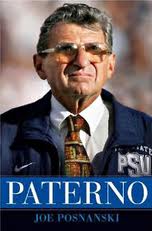by Jas Faulkner
 Joe Posnanski’s latest effort must have looked like a dream assignment to anyone with an interest in sports, especially college football. All he had to do was spend two years talking to a highly esteemed coach, his family, friends, coworkers, and past and present players. His subject was lauded as someone who ran a clean program and enjoyed the title, “America’s Winningest College Football Coach.” The book would practically write itself. As Simon and Shuster prepared to heavily promote it with an extensive author tour and booksellers everywhere anticipated a winner in spite of the brutal retail market; Posnanski saw his work take shape into the kind of biography that would be viewed as a definitive look into the life of his subject.
Joe Posnanski’s latest effort must have looked like a dream assignment to anyone with an interest in sports, especially college football. All he had to do was spend two years talking to a highly esteemed coach, his family, friends, coworkers, and past and present players. His subject was lauded as someone who ran a clean program and enjoyed the title, “America’s Winningest College Football Coach.” The book would practically write itself. As Simon and Shuster prepared to heavily promote it with an extensive author tour and booksellers everywhere anticipated a winner in spite of the brutal retail market; Posnanski saw his work take shape into the kind of biography that would be viewed as a definitive look into the life of his subject.
Posnanski was probably well past the halfway mark with his research when the story broke that former assistant coach, Jerry Sandusky was a pedophile who used his association with Penn State’s football program as bait to lure victims into his reach. The initial reports revealed multiple opportunities to stop Sandusky. In a short period of time, the media would unearth details that were not only damning of Sandusky, but of the whole program. Among the people people implicated in the cover-up was the subject of Posnanski’s book. By the time he conducted his final interview months later, the writer found Joseph Vincent Paterno, a man who once declared he was Penn State, was ailing, disgraced, and fighting to keep his legacy from being dragged into the sickening vortex of scandal.
It Gets Ugly
“The Grand Experiment: The Life and Meaning of Joe Paterno”, was a sure thing that would affirm the near deification of the coach by loyal Nittany Lions fans and bring wider recognition to a writer who had enjoyed accolades within his field for the body of work he produced covering baseball. Instead, things got ugly. Word that Paterno was negotiating a multi-million dollar, perk heavy parachute for himself before too many details got out. His refusal to take any responsibility coupled with the circling of the wagons that was taking place in the higher levels of Penn State’s administration would cause the reputation of a program originally thought to be the cleanest in the country to be ruined.
In his final days, Paterno released a statement asking that the football program not be connected with the actions of Jerry Sandusky. He agreed to be interviewed by Washington Post’s Sally Jenkins and used the interview to present what would turn out to be a highly controversial version of what happened. He claimed to have handed off the allegations about Sandusky to people he felt were qualified to handle the situation. Almost six months after Paterno’s death, The Freeh Report would suggest the head coach was far more interested in protecting his program than the children who suffered at the hands of Jerry Sandusky.
As this is being written, the university has received sanctions from the NCAA and the Big Ten conference. This is just the beginning. Governing bodies have yet to weigh in and the civil suits that are likely to be filed mean that those who are left to deal with the mess are going to find themselves very busy for years. The breadth of the penalties will cripple the football program for a long time. Pulling down a statue and dismantling a program will not return the wrecked childhoods to Sandusky’s victims. Vacating Penn State’s wins from 1998 to 2011 and removing a statue will not punish Joe Paterno. He’s dead. It’s likely he went to his grave thinking his place as the coach with the most wins was untouchable.
JoePa and JoePo
Simon and Shuster’s public relations people expressed concerns that the other Joe associated with this book, Joe Posnansky, might become too closely associated with Joe Paterno in the minds of the reading public. According to a recent Christian Science Monitor story on the problematic nature of the timing of “Paterno,” Simon and Shuster spokesperson Anne Tate was quoted as saying in an interview elsewhere:
“We’re sensitive about putting our author in forums where he might be viewed as a stand-in for his subject.”
The publisher’s response to concerns expressed within the industry about the timing of the book’s release has been swift and decisive. They have shortened the title to the less grandiose “Paterno” and have abbreviated Posnanski’s promotional tour. Sports Illustrated, an outlet that had been positive about the book, refused to run excerpts and some booksellers have announced they will not include it in their inventory.
 Before the book’s release there was criticism that Posnanski was too soft on his subject, that he persisted in presenting him in a positive light even when the mounting evidence suggested that Paterno was possibly more Machiavellian than noble. This poses some interesting questions about what role Posnanski could or should have played in the search for the truth. Had he been an unknown quantity or a hack for hire who was there to write an extended advertisement for the Paterno brand, expectations would have been lower. In fact, Posnanski is a seasoned sportswriter with an impressive resume. When the scandal hit, should Posnanski have switched gears from researching and recording a long and storied career to investigative reporting?
Before the book’s release there was criticism that Posnanski was too soft on his subject, that he persisted in presenting him in a positive light even when the mounting evidence suggested that Paterno was possibly more Machiavellian than noble. This poses some interesting questions about what role Posnanski could or should have played in the search for the truth. Had he been an unknown quantity or a hack for hire who was there to write an extended advertisement for the Paterno brand, expectations would have been lower. In fact, Posnanski is a seasoned sportswriter with an impressive resume. When the scandal hit, should Posnanski have switched gears from researching and recording a long and storied career to investigative reporting?
From the vantage point in the rare air that 24/7 coverage affords its audience, it is easy to make a snap judgment call about what might have happened behind closed doors at Penn State. It gives us the opportunity to see the situation in a decidedly different way than someone who has been on the ground for two years might view it. Social science and journalism require a degree of research in the field in order to get the story. The social sciences, anthropology, sociology and social psychology prescribe the maintenance of clinical/professional remove in order to remain subjective. Veteran journalists caution writers about getting too cosy with the people they write about. In an ideal world, this wouldn’t be a challenge. In reality we are humans talking to other humans. Our life experience, the filter through which we view the world by dint of circumstance, these things inform our writing.
In his latest Q and A video, Kevin Smith talks about the nature of art and how passion is an absolute must in order for it to work. Smith describes the difference between creative vocation and work that comes from something deeper, an impulse borne of innate passion that is impossible to ignore. In the case of Posnanski, maybe it will come down to whether readers will see his book as a crime of passion or a labour of love.

The whole story around the jerry sanduski cases is sad all the way around, Paterno’s biography should be an interesting read.
you’re right, it’s tough for everyone involved.
I winced when I heard about this project. Posnanski is a good writer and pater familias with two small children. Two years out of his life at this point is a big deal. He’ll recover because there is a body of good work to counter balance any blowback.